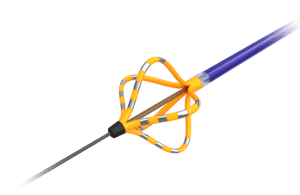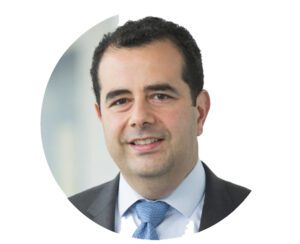Top experts at Boston Scientific, Medtronic and Acutus Medical shared insights about pulsed-field ablation’s potential at DeviceTalks Boston.

Part of the Farapulse pulsed-field ablation system, the Farawave single-shot catheter is designed to create durable and circumferential lesions. [Image courtesy of Boston Scientific]
Pulsed-field ablation is a non-thermal method for cardiac ablation that has the potential to positively disrupt the way atrial fibrillation is treated.
PFA’s roots go back to the dc ablation tech of the 1980s. These days, PFA generally involves high-voltage electric pulses from a catheter-delivered electrode or electrodes, delivered each at a tiny fraction of a second. Its potential advantages versus radiofrequency ablation or cryoablation include the characteristic that heart muscle tissue can be especially susceptible to it, while other types of surrounding tissue are injury resistant.
It’s hard these days to find a cardiac device company that is not doing something related to PFA. At our DeviceTalks Boston conference and expo in May 2022, we were lucky enough to have a panel of executives from three of the leaders in the space:
- Dr. Kenneth Stein is SVP and CMO of CRM at Boston Scientific. The company acquired the rest of Farapulse in 2021. The Farapulse PFA treated nearly 2,000 patients in nine European countries last year. It has a CE Mark, and Boston Scientific is seeking FDA clearance.
- Dr. Khaldoun Tarakji is the CMO of the Cardiac Ablation Solutions operating unit at Medtronic. The medtech giant is in the process of completing a global clinical trial of its PulseSelect PFA system. It’s conducting the study in the U.S. under an FDA investigational device exemption. Medtronic also announced in January that it plans to acquire cardiac mapping and ablation technology developer Affera for nearly $1 billion. The plan is for the deal to close in the coming months.
- Dr. Steven Mickelsen founded Farapulse and is presently the chief translational science officer at Acutus Medical. The Acutus PFA system is under investigation in CE Mark countries.
Here are some key takeaways from the panel, slightly edited for length and clarity:

Dr. Kenneth Stein is SVP and CMO of CRM at Boston Scientific [Image courtesy of Boston Scientific]
1. PFA could be safer, more effective and faster.
Stein: “The key is that myocardial tissue is uniquely susceptible to this pulse-field energy source. And as a result, you can irreversibly damage myocardial tissue without irreversibly damaging surrounding tissues. So there’s a promise that ablation for atrial fibrillation is safer because you can avoid collateral damage. Because of that, you can ablate in areas a little more aggressively than you can with thermal techniques. And therefore, there’s a promise that it may be more effective than conventional thermal techniques. And then depending on the format of the catheters, the generator, and the workflow, it clearly can be much faster than conventional energy sources. There are very few times in medicine, engineering or life where you ever get that trifecta of safer, more effective and faster. As long as we can prove out in clinical trials that it lives up to that promise, it will revolutionize ablation therapy.”
Tarakji: “I think the combination of durable lesions, effective therapy —at the same time achieving safety — that’s probably the main driver for the excitement in the EP [electrophysiology] community for pulsed-field ablation.”

Dr. Steven Mickelsen founded Farapulse and is presently the chief translational science officer at Acutus Medical. [Image courtesy of Acutus Medical]
2. There are a lot of variables around PFA, and it’s going to take time to prove results.
Mickelsen: “The field right now is very full with a lot of different strategies or recipes for pulse field. RF —an oscillating wave where you get heating and it’s predictable — there’s a pretty narrow kind of bandwidth web used universally throughout the field. But with PFA, there are a lot of options. That recipe can be a whole bunch of different engineering ways of playing with the knobs. And what I’m hoping to see is over the next five to 10 years is a convergence on what recipe works best for the heart.”
Stein: “Every RF lesion in any catheter — if it’s the same sized catheter tip and the same back patch, it’s the same lesion. PFA is very much dependent on the particular waveform, the particular energy source and the particular workflow. And one of the things to watch out if you’re trying to create your own PFA startup is to remember the biophysics. The irreversible field of injury — that is always surrounded by a large field of reversible electroporation. One of the things you learn really fast when you start doing this is you’ve got to try really hard to get bad acute results with PFA. It always looks great acute, because even if you haven’t been irreversible, you’ve got a reversible field. And so the proof of the pudding isn’t until you do three-month remaps, or you wait and look at your one-year chronic results. It’s very easy to fool yourself early. That’s part of why the development path for the Iowa Approach, which became Farapulse, took too long. And then the second thing I’d say, which was one of the things that I think Farapulse did really well, is not just take an RF catheter and try to push PFA through it. Actually, design a catheter from the ground up to use this energy source. You can put wings on a boat and tell people to fly it, but you don’t want to be a passenger in that airplane.”

Dr. Khaldoun Tarakji is the CMO of the Cardiac Ablation Solutions operating unit at Medtronic. [Image courtesy of Medtronic]
3. There are different approaches
Mickelsen: “What Acutus is looking at is that we need a flexible format that really highlights our ability to see and map AFib in real-time and choose targets based on that. And so a one size fits all didn’t necessarily meet the strategy of the company. That’s why we went with a point-by-point version of PFA. But I think every single company that’s in the space is going to have at least some offering that is a single shot, very simple, that doesn’t require the technical skills of moving around a deflectable catheter and the atrium for the purposes of a [pulmonary vein antrum isolation] tool. And then I think every one of the players in the field is also going to have a point-by-point offering because even if you do all your AFib ablation, you still have 50% of all ablations done on Earth that are not AFib.”
Stein: “No one goes out to play golf with just a single club in their bag, unless it’s me playing miniature golf. Ablation takes a lot more than just that. There is a question of integration with 3D. We have anatomic mapping systems, there’s the issue of transeptal access. We’re really excited about the technology that Baylis Medical [$1.75 billion acquisition] brought to us in, in terms of transeptal crossing. It can also come to what other things does a patient need? Do they need left atrial appendage closure with something like the Watchman device? We do as a company try to look at ourselves as not just providing widgets for people who need widgets to treat their patients, but to really provide a comprehensive toolset for the overall management for patients with atrial fibrillation.”
4. There’s still a need for innovation
Stein: “If someone had a way of knowing, ‘I can interrogate and tell whether tissue is reversibly versus irreversibly electroporated,’ that that would advance the field substantially.”
Tarakji: “You can achieve electrical silence, but that doesn’t give you the confidence of whether it’s going to be reversible or not. … Defining electrical silence, that’s easy. You put your catheter in, you can see that. But what’s reversible, what’s not? I agree, there’s still a lack of ability to do this.”